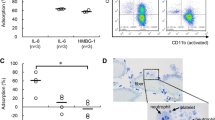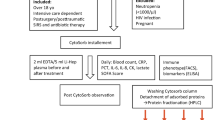Abstract
Sepsis is a systemic response to infection characterized by increased production of inflammatory mediators including cytokines. Increased production of cytokines such as interleukin-6 (IL-6), interleukin-10 (IL-10), and tumor necrosis factor (TNF) can have deleterious effects. Removal of cytokines via adsorption onto porous polymer substrates using an extracorporeal device may be a potential therapy for sepsis. We are developing a cytokine adsorption device (CAD) containing microporous polymer beads that will be used to decrease circulating levels of IL-6, TNF, and IL-10. In this paper we present a mathematical model of cytokine adsorption within such a device. The model accounts for macroscale transport through the device and internal diffusion and adsorption within the microporous beads. The analysis results in a simple analytic expression for the removal rate of individual cytokines that depends on a single cytokine-polymer specific parameter, Γ i . This model was fit to experimental data and the value of Γ i was determined via nonlinear regression for IL-6, TNF, and IL-10. The model agreed well with the experimental data on the time course of cytokine removal. The model of the CAD and the values of Γ i will be applied in mathematical models of the inflammatory process and treatment of patients with sepsis.



Similar content being viewed by others
References
J. D. Andrade. Surface and Interfacial Aspects of Biomedical Polymers. New York: Plenum, 1985,
D. C. Angus, et al. Epidemiology of severe sepsis in the United States: analysis of incidence, outcome, and associated costs of care. Crit Care Med. 29(7):1303–1310, 2001. doi:10.1097/00003246-200107000-00002
A. E. Baue. Multiple organ failure, multiple organ dysfunction syndrome, and systemic inflammatory response syndrome. Why no magic bullets? Arch Surg. 132(7):703–707, 1997
R. B. Bird, et al. Transport Phenomena. New York: John Wiley and Sons, Inc., 2007, 905
R. C. Bone, et al. Definitions for sepsis and organ failure and guidelines for the use of innovative therapies in sepsis. The ACCP/SCCM Consensus Conference Committee. American College of Chest Physicians/Society of Critical Care Medicine Chest. 101(6):1644–1655, 1992
L. Cole, et al. A phase II randomized, controlled trial of continuous hemofiltration in sepsis. Crit Care Med. 30(1):100–106, 2002. doi:10.1097/00003246-200201000-00016
A. S. Cross and S. M. Opal. A new paradigm for the treatment of sepsis: is it time to consider combination therapy? Ann Intern Med. 138(6):502–505, 2003
D. R. Garg and D. M. Ruthven. Theoretical prediction of breakthrough curves for molecular sieve adsorption columns-I Asymptotic solutions. Chem Eng Sci. 28(791–798, 1973
D. R. Garg and D. M. Ruthven. Theoretical prediction of breakthrough curves for molecular sieve adsorption columns-II General isothermal solution for micropore diffusion control. Chem Eng Sci. 28(799–805, 1973
G. E. Grau and D. N. Maennel. TNF inhibition and sepsis—sounding a cautionary note. Nat Med. 3(11):1193–1195, 1997. doi:10.1038/nm1197-1193
R. G. Harrison, et al. Bioseparations Science and Engineering. New York: Oxford University Press, 2003, 406
G. A. Heeter and A. I. Liapis. Frontal chromatography of proteins. Effect of axial dispersion on column performance. J Chrom A. 796(1):157–164, 1998. doi:10.1016/S0021-9673(97)00951-5
R. S. Hotchkiss and I. E. Karl. Cytokine blockade in sepsis–Are two better than one? Crit Care Med. 29(3):671–672, 2001. doi:10.1097/00003246-200103000-00040
J. A. Kellum, M. K. Dishart. Effect of hemofiltration filter adsorption on circulating IL-6 levels in septic rats. Crit Care. 6(429–433, 2002
J. A. Kellum, et al. Diffusive vs. convective therapy: effects on mediators of inflammation in patient with severe systemic inflammatory response syndrome. Crit Care Med. 26(12):1995-2000, 1998. doi:10.1097/00003246-199812000-00027
J. A. Kellum, et al. Hemoadsorption removes tumor necrosis factor, interleukin-6, and interleukin-10, reduces nuclear factor-kappaB DNA binding, and improves short-term survival in lethal endotoxemia. Crit Care Med. 32(3):801–805, 2004. doi:10.1097/01.CCM.0000114997.39857.69
J. A. Kellum, et al. Understanding the Inflammatory Cytokine Response in pneumonia and sepsis. Arch Intern Med. 167(15):1655-1663, 2007. doi:10.1001/archinte.167.15.1655
R. K. Lewus G. Carta. Protein diffusion in charged polyacrylamide gels. Visualization and analysis. J Chrom A. 865(1–2):155–68, 1999. doi:10.1016/S0021-9673(99)00862-6
E. S. Nylen and A. A. Alarifi. Humoral markers of severity and prognosis of critical illness. Best Pract Res Clin Endocrinol Metab. 15(4):553–573, 2001. doi:10.1053/beem.2001.0169
S. Oda, et al. Cytokine adsorptive properties of various adsorbents in immunoadsorption columns and a newly developed adsorbent: an in vitro study. Blood Purif. 22(6):530–536, 2004. doi:10.1159/000082526
K. Reiter, et al. Pro/con clinical debate: is high-volume hemofiltration beneficial in the treatment of septic shock? Crit Care. 6(1):18–21, 2002. doi:10.1186/cc1448
C. Ronco, et al. A pilot study of coupled plasma filtration with adsorption in septic shock. Crit Care Med. 30(6):1250–1255, 2002. doi:10.1097/00003246-200206000-00015
D. M. Ruthven. Principles of Adsorption and Adsorption Processes. New York: Wiley-Interscience, 1984, 433
M. Schroder, et al. Direct quantification of intraparticle protein diffusion in chromatographic media. J Phys Chem B. 110(3):1429–36, 2006. doi:10.1021/jp0542726
M. Song, et al. Cytokine removal with a novel adsorbent polymer. Blood Purif. 22(5):428–434, 2004. doi:10.1159/000080235
T. van der Poll and S. J. van Deventer. Cytokines and anticytokines in the pathogenesis of sepsis. Infect Dis Clin North Am. 13(2):413–426, 1999. doi:10.1016/S0891-5520(05)70083-0
M. van Dyke. Perturbation Methods in Fluid Mechanics. New York: Academic Press, 1964
Y. Vodovotz, et al. Mathematical models of the acute inflammatory response. Curr Opin Crit Care. 10(5):383–390, 2004. doi:10.1097/01.ccx.0000139360.30327.69
Welty, J. R., et al. Fundamentals of Momentum, Heat, and Mass Transfer. John Wiley and Sons, Inc., p. 759, 2001.
Yeagle, P. L. The Structure of Biological Membranes. CRC Press, 2004
F. Zeni, et al. Anti-inflammatory therapies to treat sepsis and septic shock: a reassessment. Crit Care Med. 25(7):1095–1100, 1997. doi:10.1097/00003246-199707000-00001
Acknowledgements
The work presented in this publication was made possible by Grant Number HL080926-02 from the National Institutes of Health (NIH): National Heart, Lung, and Blood Institute and its contents are solely the responsibility of the authors and do not necessarily represent the official views of the National Heart, Lung, and Blood Institute or NIH. We would also like to recognize the University of Pittsburgh’s McGowan Institute for Regenerative Medicine for support on this study.
Author information
Authors and Affiliations
Corresponding author
Appendices
Appendix A: Dimensional Analysis of Microtransport Equation
Normalizing the cytokine concentration using \( c^{*}_{i} \equiv {c_{i} } \mathord{\left/ {\vphantom {{c_{i} } {C^{{{\text{in}}}}_{i} }}} \right. \kern-\nulldelimiterspace} {C^{{{\text{in}}}}_{i} } \), where C in i is the concentration of cytokine in the solution flowing into the device, the Langmuir isotherm becomes
\( K^{*}_{i} \) represents a dimensionless or relative affinity expressed as
in which \( C_{{50i}} \) is the concentration of cytokine that would saturate half the polymer surface with that cytokine at equilibrium. As described in the main text, \( K^{*}_{i} \approx 10^{{ - 1}} \;{\text{to}}\;10^{{ - 3}} \) and the microtransport of cytokine corresponds to a low relative affinity regime. In this regime the properly scaled value for the dimensionless adsorbed cytokine concentration is \( q^{*}_{i} \equiv {q_{i} } \mathord{\left/ {\vphantom {{q_{i} } {(q^{{{\text{max}}}}_{i} K{}_{i}C^{{{\text{in}}}}_{i} )}}} \right. \kern-\nulldelimiterspace} {(q^{{{\text{max}}}}_{i} K{}_{i}C^{{{\text{in}}}}_{i} )} \) and the dimensionless Langmuir adsorption isotherm becomes:
The cytokine microtransport equation can be put into a dimensionless form by also normalizing the independent variables:
where R is the radius of the bead, and t s is the time scale over which cytokine levels are being depleted from circulation in application of the therapy. The dimensionless microtransport equation is
where the parameter α i is given by:
and represents a characteristic time required to load a bead with a given cytokine i. Using Eqs. (8) and (A.6), the time scale relative to the loading time is given by:
The dimensionless parameter δ i represents the amount of circulating cytokine relative to the cytokine capture capacity of the device. As described in the main text, δ i is also a small parameter, with δ i ≈ 10−5.
Appendix B: Asymptotic Analysis of Dimensionless Microtransport Equation
Microscale transport is governed by the dimensionless Langmuir adsorption isotherm (Eq. A.3) and the dimensionless microtransport equation:
An asymptotic analysis of the microscale transport requires that we properly scale the two small dimensionless parameters relative to one another. The guiding principle of least degeneracy27 used in asymptotic analyses requires that we select \( \delta _{i} \sim O(K^{{*2}}_{i} ) \). Accordingly, we define another dimensionless parameter \( \beta _{i} \equiv \delta _{i} /K^{{*2}}_{1} \sim O(1) \) and recast the dimensionless microtransport equation as
In the asymptotic limit of \( K^{*}_{i} \ll 1 \), Eq. (A.9) indicates that the diffusion-adsorption process is confined to a boundary layer of dimensionless size \( O(K^{*}_{i} ) \) at the surface of each bead. Introducing a boundary layer coordinate given by \( \eta \equiv K^{{* - 1}}_{i} (1 - r^{*} ) \) the microtransport equation, simplified in the limit as \( K^{*}_{i} \to 0 \), is:
The temporal derivative term can be simplified using the dimensionless multicomponent adsorption isotherm (Eq. A.3):
Equation (A.11) indicates that in the low relative affinity regime effects related to multicomponent adsorption (e.g. affinity-based displacement) will appear, but only in the higher order correction terms for the \( c^{*}_{i} \). The boundary layer microtransport equation becomes:
which has the following solution for \( c^{*}_{i} (\eta = 0) = 1 \):
Rights and permissions
About this article
Cite this article
DiLeo, M.V., Kellum, J.A. & Federspiel, W.J. A Simple Mathematical Model of Cytokine Capture Using a Hemoadsorption Device. Ann Biomed Eng 37, 222–229 (2009). https://doi.org/10.1007/s10439-008-9587-8
Received:
Accepted:
Published:
Issue Date:
DOI: https://doi.org/10.1007/s10439-008-9587-8




